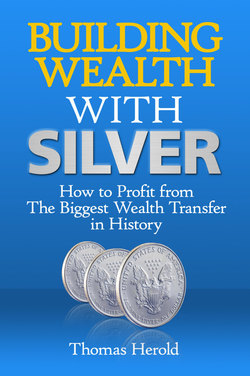Читать книгу Building Wealth with Silver - Thomas Herold - Страница 24
На сайте Литреса книга снята с продажи.
Daisies and Dollars – Beautiful to Look At, Impossible to Eat
ОглавлениеYou may be wondering at this point how it is possible that the dollar has fallen off a cliff to the tune of 3,285 percent in forty years. It is not as a result of the fall of the U.S. economy. Even though the country’s economic leadership has taken its share of hard knocks in the last forty years, the U.S. economy remains unquestionably the largest and most vibrant in the entire world.
The other G7 countries of Japan, Germany, Great Britain, France, Italy, and Canada, plus China, when all combined, still do not surpass the United States’ Gross Domestic Product, or total value of all goods and service produced in a year.
The dollar’s upsetting longer term value problem does not lie with the U.S. economy or credit rating, or any other single factor.
The dollar’s problem stems from the fact that since President Nixon’s monumental move in 1971, it no longer has any intrinsic value at all. You might be unclear on the notion of intrinsic value. The word intrinsic as described by Merriam Webster relates to a value that belongs to the constitution or essential nature of a thing.
Intrinsic pertains to the inner nature and worth of something based on its own merits. A diamond has intrinsic value because of its purity, quality, clarity, sparkle, and rarity. Similarly, gold has intrinsic value that results from its luster, color, historical worth, and rarity.
But the dollar, or any other paper currency not backed up by gold, has nothing intrinsic to it. It is a simple piece of paper with colored ink on it. It is neither shiny nor glamorous looking. It is certainly not rare.
Instead the dollar’s intrinsic value is now based on perception of its worth. This is much like the value of stocks and similar assets, whose values stem from the underlying perception of real value that is derived from every business aspect, both intangible and tangible in nature. You are probably asking yourself who decides the perception of the dollar’s worth?
The international currency markets determine any currency’s worth these days since the gold standard was abandoned. This is more or less done through market oriented forces of supply and demand. You know that demand for the dollar has remained strong over the decades.
Even after the hits that it has taken, the dollar still remains the world’s reserve currency for now, as it was back in the fifties, sixties, and seventies. If demand for the dollar continues to be strong, then what explains the 3,285 percent drop in its real value?
Part of the answer is the other side of the supply and demand side of the equation, supply. The government has a long history of printing more dollars year in and year out. President Nixon did it to the tune of ten percent more dollars in 1971.
Presidents George W. Bush and Barack Obama have engaged in this massive supply increase of dollars on a scale hardly imaginable a decade ago.
It is no exaggeration to say that the money supply of dollars has been literally increased by in excess of 300 percent in the last three to four years alone.
This supply has dramatically impacted the value and purchasing power of the dollar as is evidenced by the dropping value of the dollar against gold in a similar time frame.
In the first ten years of the new millennium, the dollar has fallen from $276.50 to $1,320 so far for 2010. This represents a 377 percent drop in the dollar’s constant value against gold. Since the dollar no longer has any actual intrinsic value, it depreciates significantly when the supplies of it are substantially increased.
Confidence is the other factor that lends the dollar its value. Since the value of the greenback is ultimately based on the full faith and credit of the U.S. government, its perceived value has become of paramount importance. Confidence is a funny, transient thing that takes years, even decades to build up. It can be destroyed in days, weeks, and months.
The Al Qaida terrorists’ declaration of war against the United States with 9/11 represented a blow to the confidence in the nation and its currency. The financial crisis which originated in and centered on bad U.S. investment practices has been another, psychologically more devastating one.
These last few years’ massive increase in government debt to an unsustainable level of $14 trillion represents still a third. As confidence in the Untied States has eroded over the last ten years, so has the perceived value of the dollar fallen commiserate with it.
You can expect the roller coaster ride of the U.S. dollar’s value to continue in the future. Until and unless it is once again tied to something of real intrinsic value like gold, its fortunes will fluctuate up and more likely down based on supply, demand, and confidence.
Strap on your seat-belts, it is going to be a bumpy ride.
